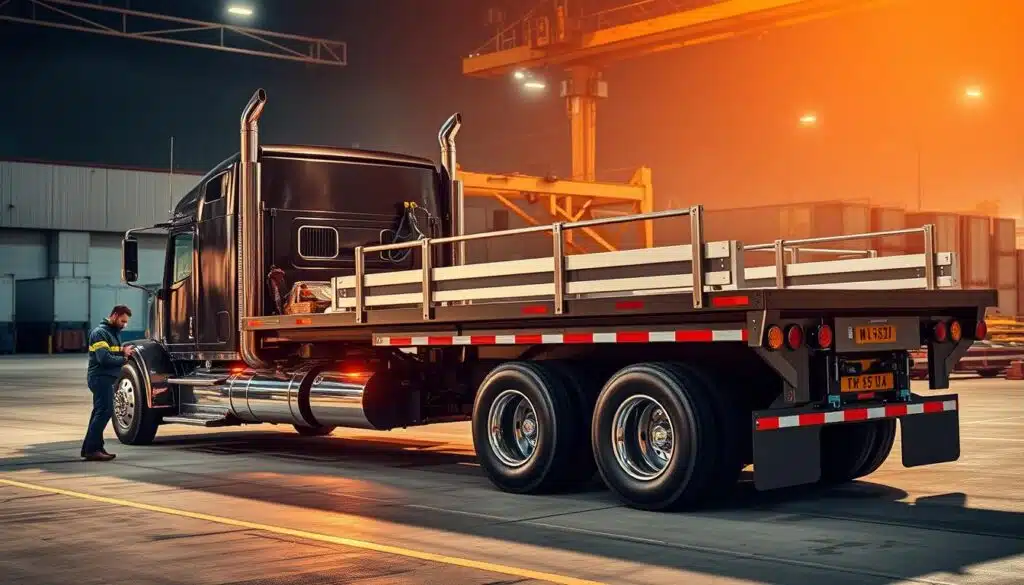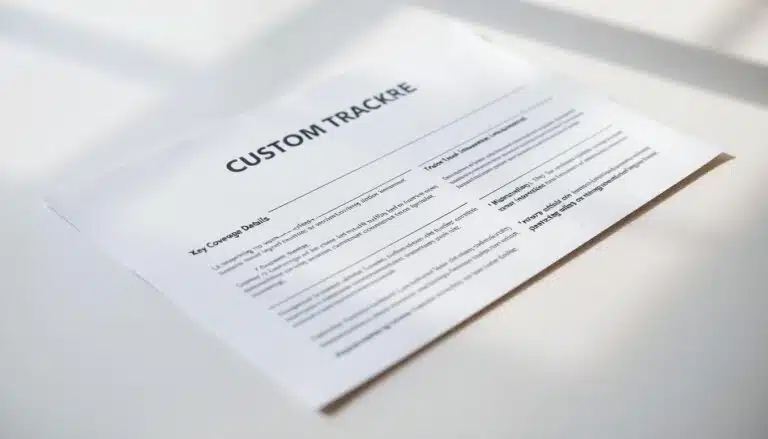Operating any type of commercial vehicle comes with unique risks that standard protection plans often miss. Whether you manage a fleet for business purposes or drive a modified pickup, generic coverage can leave dangerous gaps in your financial safety net.
This guide helps you understand why tailored protection matters. You’ll learn how to match your specific operational needs with the right level of security. The goal is finding that perfect balance between comprehensive safety and affordable costs.
Factory-specification vehicles and heavily modified rigs have very different requirements. Standard auto protection typically doesn’t account for aftermarket parts, specialized equipment, or unique cargo. Understanding these differences is crucial for proper risk management.
Both commercial operations and individual owners will find valuable insights here. This foundation prepares you to critically evaluate your current arrangement and identify where personalized adjustments could offer better value and protection.
Key Takeaways
- Standard protection often misses critical gaps for specialized vehicles
- Tailored coverage balances comprehensive safety with cost-effectiveness
- Modified vehicles require different protection than factory-spec models
- Aftermarket parts and specialized equipment need specific consideration
- Both commercial and individual owners benefit from personalized plans
- Understanding your vehicle’s true value is essential for proper coverage
- Critical evaluation of current arrangements can reveal improvement opportunities
Understanding Your Business’s Unique Insurance Needs
Commercial hauling operations vary dramatically, requiring individualized risk assessment before selecting appropriate safeguards. A thorough evaluation of your specific circumstances forms the foundation for effective protection.
Identifying Your Operational Risks
Begin by examining your daily business activities. Consider the geographic areas where your trucks operate most frequently. Urban routes present different challenges than rural ones.
Environmental factors also impact your operations significantly. Assess whether your primary service areas face extreme weather conditions. These considerations directly affect your risk profile.
Analyzing Cargo and Fleet Requirements
The nature of transported goods determines specific coverage needs. High-value items require different protection than standard merchandise. Special handling requirements increase potential liabilities.
Your fleet composition influences protection decisions. Newer vehicles might need comprehensive safeguards. Older trucks could benefit from alternative approaches based on current value.
| Risk Factor | Urban Operations | Rural Operations | Specialized Cargo |
|---|---|---|---|
| Collision Frequency | High | Medium | Variable |
| Environmental Hazards | Low | High | Medium |
| Theft Potential | High | Low | High |
| Regulatory Complexity | High | Medium | High |
Regulatory compliance remains crucial for all trucking enterprises. State-specific requirements, particularly in regions like California, demand careful attention. Proper coverage helps mitigate legal exposure.
Customizing Your Truck Insurance Policy to Fit Your Needs
Building individualized financial protection starts with understanding your unique transportation challenges. This process ensures your commercial vehicle safeguards match actual operational requirements rather than generic standards.
Defining Your Coverage Priorities
Identify which risks threaten your business most significantly. Cargo damage, liability exposure, and operational downtime often rank high. Focus protection where it matters most.
Consider your revenue streams and potential losses. High-value shipments may need different safeguards than standard freight. Driver experience and route characteristics also influence priority decisions.
Tailoring Policies to Your Trucking Operations
Match coverage types to your specific hauling activities. Fleet size, cargo value, and geographic operations determine appropriate protection levels. Regional regulations require careful attention.
Select limits that reflect your actual exposure. Over-insuring wastes resources while under-insuring creates vulnerability. Work with professionals who understand commercial vehicle requirements.
Balancing Protection with Cost
Higher deductibles can reduce premium expenses if your financial capacity allows. This strategy maintains essential coverage while managing immediate costs.
Customized plans often provide better long-term value despite initial investment. They eliminate unnecessary expenses and target protection where truly needed. This approach creates predictable financial planning for your business.
Selecting the Right Coverage Types for Your Truck
Effective risk management for your fleet begins with a thorough evaluation of mandatory and optional coverage categories. Understanding what each type protects helps you build a solid foundation.
You need to match these safeguards to your specific business activities. This ensures comprehensive protection without paying for unnecessary features.
Liability and Physical Damage Considerations
Liability protection is a legal requirement in California and most states. It covers costs if your vehicle causes injury or property damage.
Assess if standard limits are enough. High-risk areas or hazardous materials often need increased liability.
Physical damage coverage has two main parts. Collision handles accident repairs. Comprehensive covers events like theft or weather.
Consider your fleet’s age and value. Newer vehicles usually need full coverage. Older trucks might only require limited protection.
Cargo Insurance and Specialized Additions
The value and nature of your goods dictate cargo insurance needs. High-value or hazardous items require stronger limits.
This shields your business from devastating financial losses. It is an essential layer of security for any hauling operation.
Specialized options address unique needs. These include on-hook towing or non-owned trailer coverage.
Non-Trucking and Additional Liability Options
Non-trucking liability, or bobtail insurance, covers personal use of the vehicle. It fills a critical gap when the truck is not on a business job.
This prevents situations where no policy provides adequate protection. It is a smart addition for many operators.
| Coverage Type | Primary Protection | Key Consideration |
|---|---|---|
| Liability | Third-party injury/property damage | Mandatory; assess limit adequacy |
| Physical Damage | Your vehicle repairs | Vehicle age and value |
| Cargo Insurance | Goods being transported | Cargo value and risk level |
| Non-Trucking Liability | Personal use incidents | Fills commercial policy gaps |
Working with a specialized agent ensures you get the right combination. They understand the industry’s complexities and can recommend optimal configurations.
Evaluating Additional Policy Options and Endorsements
Beyond standard safeguards, additional policy features can address specific vulnerabilities in your hauling operations. These specialized add-ons provide crucial protection where basic plans often fall short.
Exploring On-Hook Towing and Trailer Coverage
If your operation includes towing services, on-hook coverage becomes essential. This endorsement protects vehicles being towed while attached to your rig.
Non-owned trailer coverage is vital for backhauling operations. It safeguards against liability and damage to third-party trailers during return trips.
Understanding Policy Endorsements
Business interruption insurance, also called downtime coverage, offers financial stability during unexpected disruptions. It compensates for lost income when vehicles are inoperable due to covered incidents.
Carefully review each endorsement’s terms and limitations. Assess which options provide genuine value for your specific operations versus unnecessary expenses.
Strategic selection of these add-ons creates comprehensive protection without wasted resources. Focus on endorsements that match your actual risk exposure and operational profile.
Optimizing Deductibles and Claim Discounts
Managing premium expenses while maintaining adequate protection requires careful consideration of deductible options and safety incentives. This approach helps balance immediate costs with long-term financial stability.
Strategic planning can significantly impact your overall financial outlay. Understanding how deductibles and discounts interact is crucial for effective cost management.
Benefits of Higher Deductibles
Increasing your deductible amounts can lower premium rates substantially. This strategy works well for businesses with strong financial reserves.
You must assess your ability to handle higher out-of-pocket expenses during claims. Companies with solid emergency funds benefit most from this approach.
| Deductible Level | Premium Savings | Risk Exposure | Best For |
|---|---|---|---|
| $500 | Standard Rates | Low | New Businesses |
| $1,000 | 15-20% Savings | Medium | Established Fleets |
| $2,500+ | 25-35% Savings | High | Strong Cash Reserves |
Implementing Safety and Maintenance Discounts
Proactive risk reduction measures qualify you for significant premium discounts. Insurers reward businesses that demonstrate commitment to safety.
Advanced security systems and driver training programs reduce accident potential. Regular maintenance schedules also contribute to lower risk profiles.
Telematics monitoring and safety technology installations provide concrete evidence of safe operations. These investments often pay for themselves through reduced insurance costs.
Regularly Reviewing and Adjusting Your Coverage
Maintaining adequate protection requires ongoing attention as your business evolves. The transportation industry changes constantly with new regulations and market shifts.
An annual review of your safeguards ensures they match current operations. This prevents paying for obsolete features while closing dangerous gaps.
Monitoring Business Growth and Changes
Track significant operational milestones throughout the year. Document fleet expansions, new hires, or service area changes.
These developments directly impact your risk profile. Your protection must adapt to maintain proper security levels.
Negotiating Updated Terms with Providers
Use annual reviews as opportunities to discuss better terms with your insurance provider. Present documentation of safety improvements and claims history.
This strategic approach can secure favorable rates that reflect your actual risk profile. It ensures your investment delivers maximum value for evolving needs.
Leveraging Expert Advice for Insurance Customization
The intricate nature of transportation risk management demands consultation with professionals who understand the trucking sector. General insurance agents often lack the specific knowledge needed for commercial vehicle operations.
Specialized expertise provides critical insights for optimizing your commercial vehicle protection strategy. These professionals navigate complex regulations and industry-specific requirements.
Consulting Specialized Insurance Professionals
Working with trucking-focused insurance professionals ensures your coverage aligns with industry-specific requirements. They understand federal motor carrier safety standards and state mandates.
These experts guide you through complex decisions about limits and endorsements. Their relationships with specialized carriers provide access to competitive quotes and tailored options.
Industry specialists stay current on emerging risks and new coverage products. This ongoing consultation helps adapt your protection as your business evolves.
Key benefits include:
- Access to carriers specializing in commercial vehicle protection
- Guidance on adequate liability limits and cargo coverage
- Understanding of interstate commerce regulations
- Ongoing support as industry requirements change
Specialized Considerations for Custom and Commercial Trucks
When your pickup reflects personal craftsmanship or professional modifications, generic coverage fails to protect your true investment. These vehicles demand specialized protection that accounts for their enhanced features and commercial applications.

Addressing Unique Customization Needs
Standard auto protection typically excludes aftermarket enhancements. Custom Parts and Equipment coverage becomes essential for modifications like lift kits or specialized audio systems.
Document all upgrades with receipts and photographs. This evidence supports proper valuation during claims processing.
Agreed Value and Aftermarket Parts Coverage
Agreed value protection ensures compensation reflects your actual investment. It replaces standard depreciation calculations with predetermined amounts.
This approach benefits heavily modified or classic vehicles. It provides certainty about reimbursement following total loss incidents.
Integrating Commercial Trucking Requirements
Commercial operations need appropriate liability limits and cargo safeguards. These requirements complement customization protections.
Ensure compliance with federal and state regulations. Proper integration creates comprehensive security for business assets.
Conclusion
Securing the right financial safeguards for your commercial vehicles represents a critical business decision. Proper protection ensures your operations continue smoothly despite unexpected events.
A comprehensive approach involves assessing your specific risks and coverage needs. This prevents paying for unnecessary features while closing dangerous gaps.
The investment in tailored safeguards pays dividends through reduced long-term financial exposure. It provides confidence to focus on growing your enterprise without constant worry about inadequate limits.
Take action today by consulting specialized providers who understand commercial vehicle requirements. Implement the strategies outlined to secure optimal protection for your unique operations.


